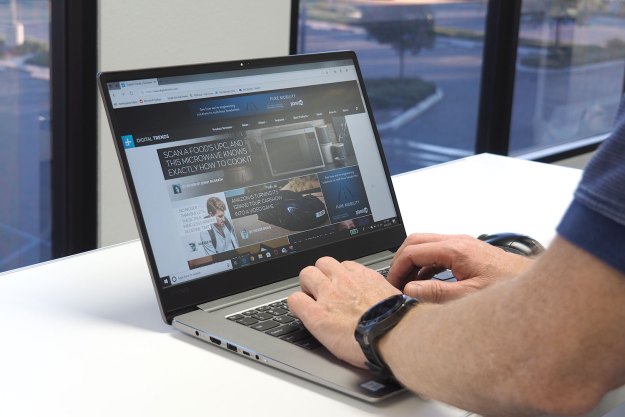“You can find this all-in-one street-priced less than $500, but ultimately, you”
- Inexpensive; consumes little power; thin and wall-mountable; built-in DVD burner
- Slow for all but the most basic tasks; tiny hard drive; wired (PS/2!) mouse and keyboard; DVD-decoder software not included
Summary
When considering which PC to buy, the terms “all-in-one” and “performance” needn’t be mutually exclusive: Look no further than Dell’s XPS One, HP’s TouchSmart, or Apple’s iMac product lines for proof. These machines are outfitted with components that render them strong enough to keep up with most mainstream conventional desktop rigs. ViewSonic’s All-in-One VPC100 is a whole ‘nother kettle o’ bits, though. While it’s true this computer is priced several hundred dollars less than those other machines, the manufacturer’s component choices sadly render it fit only for the simplest of computing tasks.

Intel’s Atom made the super-light, super-cheap netbook possible, but ViewSonic has tapped this low-power (in both senses of the word) CPU to manufacture a cheap desktop machine, joining the likes of Asus, Averatec, and MSI in this market segment.
Like its competitors, most of the VPC100’s specifications (aside from its 18.5-inch display) make it sound more like a netbook than a desktop computer. It features an Atom N270, a single-core 32-bit CPU that runs at 1.6GHz; 1GB of DDR2 SDRAM memory; integrated mobile graphics (in the form of Intel’s 945GSE chipset); and a 2.5-inch 160GB hard drive. The system’s built-in wireless networking capability is limited to 802.11b/g, but it does boast a gigabit wired Ethernet adapter. The four-in-one media-card reader can accommodate XD, SD, MMC, and MS media.
There’s a tray-mount Super-Multi DVD/CD-RW on the right side of the machine, and ViewSonic provides rudimentary software for burning CDs and DVDs, but if you want to watch Hollywood DVDs on the machine, you’ll have to provide your own DVD-decoding software (a commercial decoder costs about $15). If you think that’s a tacky omission (we certainly do), the ViewSonic advertisement that serves as the default Windows desktop screen will really have you cheesed off.
This being an all-in-one PC, expansion opportunities are limited to devices you can plug into the machine’s USB ports; unfortunately, you’ll find just four of these (two of which are inconveniently located in the rear of the machine). You’ll also have to do a reach-around to plug in a set of headphones or an external mic. The integrated stereo speakers, powered by a tiny two-watt-per-channel amp, aren’t terrible, but you won’t want to spend a lot of time listening to them either.

The computer is thin and light (it’s 1.38 inches thick and weighs 11.73 pounds) and can be mounted to a wall, as impractical as that might be considering that it comes with a wired mouse and keyboard. Both these peripherals rely on ancient PS/2 connectors, a 20-year-old input/output standard that’s vastly inferior to USB. The keyboard includes buttons for controlling software media players (play/pause, fast-forward/rewind, etc.) and launching a web browser and email client, but we found its key layout to be annoying. There’s a set of arrow keys in the familiar inverted-T formation, for instance, but the Home, End, Page-up, and Page-down keys are embedded in the numeric keypad. This forces you to either turn off Num-lock or hold down the Function key to use them.

The VPC100 draws power from a small external brick, which helps reduce its need for fans to keep the system cool. This not only contributes to its low power draw—the machine consumed just 35 watts at idle and only 38 watts during our Photoshop benchmark—but it rendered the machine exceedingly quiet. In fact, the netbook we were using to take notes while running our benchmarks emitted more noise than the VPC100.
Speaking of benchmarks, we found we weren’t able to run most of our typical suite. We couldn’t run PCMark Vantage, for instance, because it depends on Windows Vista (and the Atom processor isn’t capable of running that OS). And Far Cry 2 wouldn’t even launch, so don’t buy this machine if you’re thinking of playing anything other than very simple or Web-based games.
We were able to run our Photoshop benchmark, though, and the VPC100’s performance was more than a little disappointing. We took a digital photo shot in raw format with an Olympus C-8080, loaded it into Photoshop CS3, and then sequentially applied and undid every one of the program’s filters. Nearly all the filters consumed more than 50 percent of the CPU’s resources, and several—including Radial Blur and Dust & Scratches—totally monopolized the processor. The machine wound up spending 11 minutes and 11 seconds to complete the benchmark. Compare that to the last desktop machine we benchmarked, HP’s Pavilion Slimline s5160f, which performed the same task in just two minute and 47 seconds.

If your computing needs are extremely basic—meaning you use a computer only for web-browsing, email, word processing, and other light productivity tasks—the VPC100 should meet your needs. But most people will soon find themselves chafing at its limitations.
Pros:
- Inexpensive
- Includes DVD-burner
- Consumes little power
- Wall mountable
Cons:
- Slow performance with demanding applications
- Too few USB ports
- Very small hard drive
- Difficult to expand
- Cheap mouse and keyboard
Editors' Recommendations
- Even 15-inch portable monitors come in OLED now
- Snapchat now has restaurant reviews. Here’s how to view them
- The best monitors for designers
- Get to the task with Windows 10’s Task View and Aero Snap
- Save on ViewSonic, Acer, and LG monitors at Amazon on Black Friday


